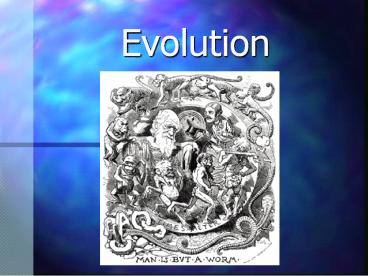Evolution - PowerPoint PPT Presentation
Title:
Evolution
Description:
Evolution Evolution The change in the gene pool of a population from generation to generation. It is important to remember that individuals do not evolve, populations ... – PowerPoint PPT presentation
Number of Views:267
Avg rating:3.0/5.0
Title: Evolution
1
Evolution
2
Evolution
- The change in the gene pool of a population from
generation to generation. - It is important to remember that individuals do
not evolve, populations evolve. - All the genes in a population are called the gene
pool. - The ratio of different alleles in that population
can change over time. - As the ratio changes, so evolution occurs.
3
Evolution
- Modern evolution theories are a mixture of the
theories of Darwin together with new evidence
from our knowledge of genetics, fossil records,
comparative anatomy, physiology and biochemistry.
4
Cuvier (1769 1832)
5
Cuvier (1769 1832)
- This French anatomist is largely responsible for
the development of Palaeontology. - He recorded the succession of fossils in the
Paris Basin. - He recognised that the fossils of simpler
organisms were in the oldest rock strata, and
that there were many extinctions. - Cuvier believed that species were fixed.
6
Cuvier (1769 1832)
- He thought that the boundries between strata were
caused by catastrophes like drought, fires and
floods. - Cuvier thought that the effects of extinctions
were probably localised and that after the
catastrophe passed, new organisms from the
surrounding areas would repopulate the area. - Called Catastrophism.
7
Lamarck (1774 1829)
- In 1809 Lamarck proposed that organisms could
gradually bring about changes in themselves to
suit the environment and that these changes could
be passed on to their offspring. - This was known as the Inheritance of acquired
characteristics
8
Lamarck (1774 1829)
- As far as we now know this is not possible as
changes in somatic cells can not be passed on to
offspring.
9
(No Transcript)
10
Darwin (1809 1882)
11
Darwin (1809 1882)
- Charles Robert Darwin is known as the Father of
Evolution - He thought that there was a unity of life, and
that all organisms were related through a common
ancestor. - He thought similar things could be grouped
together, he used Linnaeus taxonomy to group his
organisms together.
12
Darwin (1809 1882)
- Darwin showed that species do not remain
unchanged over time.
13
(No Transcript)
14
Darwins Reasoning
- All organisms have a high reproductive rate, but
food supply and other essentials are limited
leading to a struggle for existence amongst the
offspring. - There is genetic variation amongst the offspring
and some are better adapted for survival.
15
Darwins Reasoning
- Organisms with these variations will survive
longer and reproduce. - Over time, each progressive generation will be
better adapted to the environment. Survival of
the Fittest. - Eventually, new species will evolve from old
ones. This is called Natural Selection.
16
Sources of Heritable Variation
- The only things that can cause variation are
mutations and sexual recombination.
17
Mutations
- The only source of new alleles is mutation.
- These mutations are rare and random.
- Only a mutation in cell lines which lead to the
formation of gametes are passed on. - These are usually harmful and are normally
carried in the recessive condition. - Occasionally a mutation is good for adaptation to
an environment it may be an advantage to
offspring.
18
Mutation
- Over a long period of time these advantageous
mutations may become established in the
population.
19
Sexual Recombination
- During meiosis the homologous chromosomes line up
at the equator of the spindle in pairs, with one
going to each end of the cell. - In humans there are 223 (8 388 608) possible
combinations of chromosomes in a gamete. - Sexual reproduction then mixes these gametes with
those from another person who has also had his
chromosomes separated randomly
20
Sexual Recombination
- To increase the variation of genes, the swapping
of pieces of chromosomes in crossing over at
meiosis leads to even greater differences.
21
Agents that Change Gene Frequency
- Natural Selection
- some combinations of alleles are more likely to
help survival and reproduction thus their
frequency in the gene pool will steadily increase
form one generation to the next.
22
Agents that Change Gene Frequency
- all populations has a large range of phenotypes,
which usually fall into a normal distribution
curve. The selective forces such as predators,
competition, disease, food, light, water, climate
etc act on the phenotypes as follows - Stabilising selection
- Directional Selection
- Disruptive Selection
23
Stabilising Selection
- This favours the average over the extremes.
24
Directional Selection
- This favours one extreme over the average and
other extreme.
25
Disruptive Selection
- This favours both extremes over the average.
26
Agents that Change Gene Frequency
- Genetic Drift
- This occurs in small populations
- It can cause evolution by chance fluctuations in
the gene pool of a small population. - It is the change in the gene pool of a small
population due to chance.
27
Genetic Drift
28
Founder Effect
- Founder Effect
- this is due to a limited no of ancestors.
29
The Founder Effect
30
Agents that Change Gene Frequency
- Mutation
- this is the ultimate source of variation.
- Gene Migration
- (immigration and emigration) when immigrants
arrive form another population with a different
gene pool, new alleles are introduced. - NB mutation and immigration increase genetic
variety, natural selection, emigration and
genetic drift decrease it.
31
(No Transcript)

